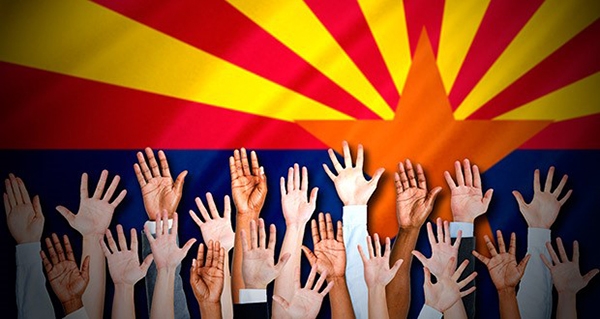
Newsroom

Survey sets the stage for future of volunteerism in Arizona

Arizona volunteerism study answers
The Arizona volunteerism study received hundreds of answers to the question, “Thinking three to five years out, what important existing and emerging community needs could be effectively addressed by service and volunteerism?
Here is a sampling of the answers:
“There is a large need for mentors in the schools. Tutoring is expensive. Mentoring with a mix of tutoring could benefit the schools and the people who want to work with youth programs. Elementary schools need people to read with children to provide more one-to-one reading time. There is a large population of adults who need English skills, and the community centers always seem a bit short- staffed to address the needs of all of the people who want language classes and tutoring in English. There is also a need for additional computer training classes for adults and people transitioning from one job who want to find something new and different from their old type of work.”
“Overpopulation of animals is a big problem in the entire country but Maricopa is among one of the areas that has biggest problems so it is critical that we get volunteers out in the area to discuss the need to adopt rather than purchase, the importance of spay/neuter programs and general education around dog fighting and other areas that need attention. Without the help of many volunteers continuously spreading the word we will not see a positive change in our communities.”
“More activities for special needs youths and adults, more availability for food and other necessities for lower income families, home repair assistance for elderly and lower-income families.”
“The main problems in my eyes would be to address the poverty issue in relation to changing demographics and also to focus on any educational setbacks to come due to a lack of resources.”
“Youth in economically disadvantaged areas of the state, particularly in Phoenix – more volunteers some more money and we could collectively make a huge difference in the whole lives of hundreds of boys and girls.”
“We’ll need to serve older seniors (who are living longer) younger seniors (who are still “booming” & not fully understanding of the needs they will have) & children (who will continue to be stressed by our societal ills).
“We need to push education. Arizona and the U.S. as a whole are falling behind. The community needs to take a lead to push our youth ahead in many youth aspects, including education, physical health/education, financial well-being, etc. The Foster Care System could use assistance and this, too, will assist in a positive future for AZ.”
![]()
By: Tom Spratt | Arizona Capitol Times | July 28, 2014, 9:08 am (link here)
To many Arizonans, volunteerism has become a force to be reckoned with, improving economic opportunities for thousands, providing essential help for children and encouraging the humane treatment of animals.
To others, it is far from perfect, hindered by a lack of coordination, low visibility and the failure of many businesses to participate.
To assess the state of volunteerism in Arizona, a governor’s commission worked with the Lodestar Center for Philanthropy & Nonprofit Innovation at Arizona State University. The result was “Arizona Volunteerism Today and in the Future,” a report that features viewpoints and suggestions from many of the nearly 1,000 Arizonans who took part in the survey.
The survey led to a new State Service Plan for Arizona, 2013-2015, which sets goals and strategies to promote community service and volunteerism. It also offers suggestions for enhancing the ability of the Corporation for National and Community Service (AmeriCorps) to address community needs in the state. And it provides strategies for strengthening Arizona’s volunteerism infrastructure.
The authors of the study are Bob Shogren, director of the Governor’s Commission on Service and Volunteerism; Stephanie La Loggia, manager of knowledge resources for the Lodestar Center; and Karina Lungo, a researcher for the center. Their findings were based on 20 focus groups held throughout the state and an online survey that drew 609 responses. The full report can be read HERE.
Shogren took the time to answer questions about the value and significance of the study.
How specifically will the results be used to strengthen Arizona’s service and volunteerism infrastructure?
To be in compliance with the Code of Federal Regulations, 45 CFR § 2550.80, “What are the duties of the state entities?” the Governor’s Commission on Service and Volunteerism spent last spring gathering public input for the development of a three-year statewide service plan that is consistent with the broad goals of the Corporation for National and Community Service and includes plans for promoting service and volunteerism in Arizona.
Through 20 face-to-face community focus groups and an online survey, 952 Arizonans from 67 hometowns and 14 counties provided their input. The information obtained through the focus groups and survey was analyzed by researchers at the ASU Lodestar Center for Philanthropy and Nonprofit Innovation. Key Findings included:
- Volunteerism continues to be an active force that addresses a wide range of community issues and needs
- Helping to ensure a sound economic future for our state and all of its residents is a priority
- The best chance we have to fully meet needs and effectively address community issues is through collaboration and collective action
- More awareness is needed to reinforce the value and elevate the status of volunteerism and service
- The best recognition is public recognition
- Better online tools (and training to best utilize those tools) are needed.
The commission adopted the new State Plan for Volunteerism and Service on Oct. 23, 2013, which included goals aimed at strengthening Arizona’s service and volunteerism infrastructure. The broad goals of the plan include:
- Support volunteer administrators (those who manage volunteer programs in organizations, communities, and schools)
- Assist with training, tools, and capacity building for organizations that work with volunteers
- Bolster awareness of community volunteer programs, including volunteer recognition
- Facilitate increased community collaboration.
The overarching goal is to increase Arizona’s volunteer rate (the percentage of people who volunteer), and help organizations better engage and retain volunteers.
Can you provide an example of one notable group or activity whose infrastructure could be improved with help from the study?
According to the Volunteering and Civic Life in America report, Arizona currently ranks 41st among the 50 states and Washington, D.C. on volunteerism. Gov. Jan Brewer’s goal is to move the needle forward on this measure. From the information gathered for this report, it is evident that volunteerism and volunteer efforts are alive and well across the state. However, some organizations and institutions do exceedingly well with volunteer programs and some don’t.
So it is our hope to find meaningful ways to better connect volunteer programs together at the community level, regional level and state level. There are many individuals and organizations, programs and individuals in Arizona with an incredible amount of practical experience, knowledge, and true wisdom. It is our intention to build relationships among programs, as we all work together to build our communities and our state. Additionally, we hope to focus on the task of better supporting Arizona’s volunteer managers, connecting them with support, training, and tools. These efforts will help to build the capacity of organizations, which in turn leads to positive community outcomes.
What is the potential for improving participation by AmeriCorps and how specifically might that help volunteerism in the state?
Leveraging national service resources through AmeriCorps can provide organizations and communities additional human resources to organize, build and sustain new programs that can meet community needs in new ways.
When is the State Service Plan going into effect, and what tangible results would you hope to achieve during the next five years?
The State Plan was adopted by the commission in October 2013. In the next five years, it would be great if we could move the needle on Arizona’s ranking in volunteer service and community engagement (the Volunteer and Civic Life report). And it would be great to elevate attention to volunteerism in Arizona in a way that reflects the true nature and spirit of our citizens, recognizes and appreciates the depth to which volunteerism is embedded in our cultural fabric and connects our organizations and communities together. Helping to build a vision for volunteerism in Arizona that would help to drive and align collaborative efforts would be a worthy accomplishment.
Key Conclusion from the Survey
- "Volunteerism continues to be an active force that addresses a wide range of community issues and needs"
Notable challenges facing volunteerism in Arizona
Comments from those who responded to the survey
- “A lack of coordination. Volunteerism is fragmented, uncoordinated, disorganized.”
- “A lack of awareness. Limited or no visibility of volunteerism.’’
- “We are getting fewer volunteers than in the past because people tend to be working longer.”
- “We are weak in rewarding our volunteers.”
- “We need more younger people.”
- “There needs to be more opportunities for youth, especially younger youth (11-14 years old.)”
- “Most people who participate are individuals who work for nonprofits. There is very low participation from the general public.”
- “Employers are not encouraging community service as much as they should.”
What one improvement in Arizona volunteerism would you most like to see accomplished as a result of this study?
It feels that this report helps to extend what we know about volunteerism in Arizona and helps point out potential directions for future study. At present, it seems that there are a number of noteworthy efforts to strengthen volunteerism and civic participation in Arizona. Helping to build a vision for volunteerism in Arizona that would result in the development of a statewide coalition of organizations and citizens dedicated to growing the number of Arizonans involved in meaningful community service. If we could raise the volunteer rate in Arizona, it would dramatically increase the resources flowing to important community causes such as youth, economic initiatives, arts and culture, and education. Volunteers are more active and engaged citizens, give more to charitable and community causes, and enjoy a number of personal benefits such as an increased sense of purpose and better general health. So it makes sense to invest in volunteer and community service.
What was the cost of the study?
In addition to commission staff time and effort, the cost of the report was $2,548. In addition, due to the nature of the report, the ASU Lodestar Center for Philanthropy and Nonprofit Innovation contributed in-kind resources to the analysis, writing, and presentation of report findings.